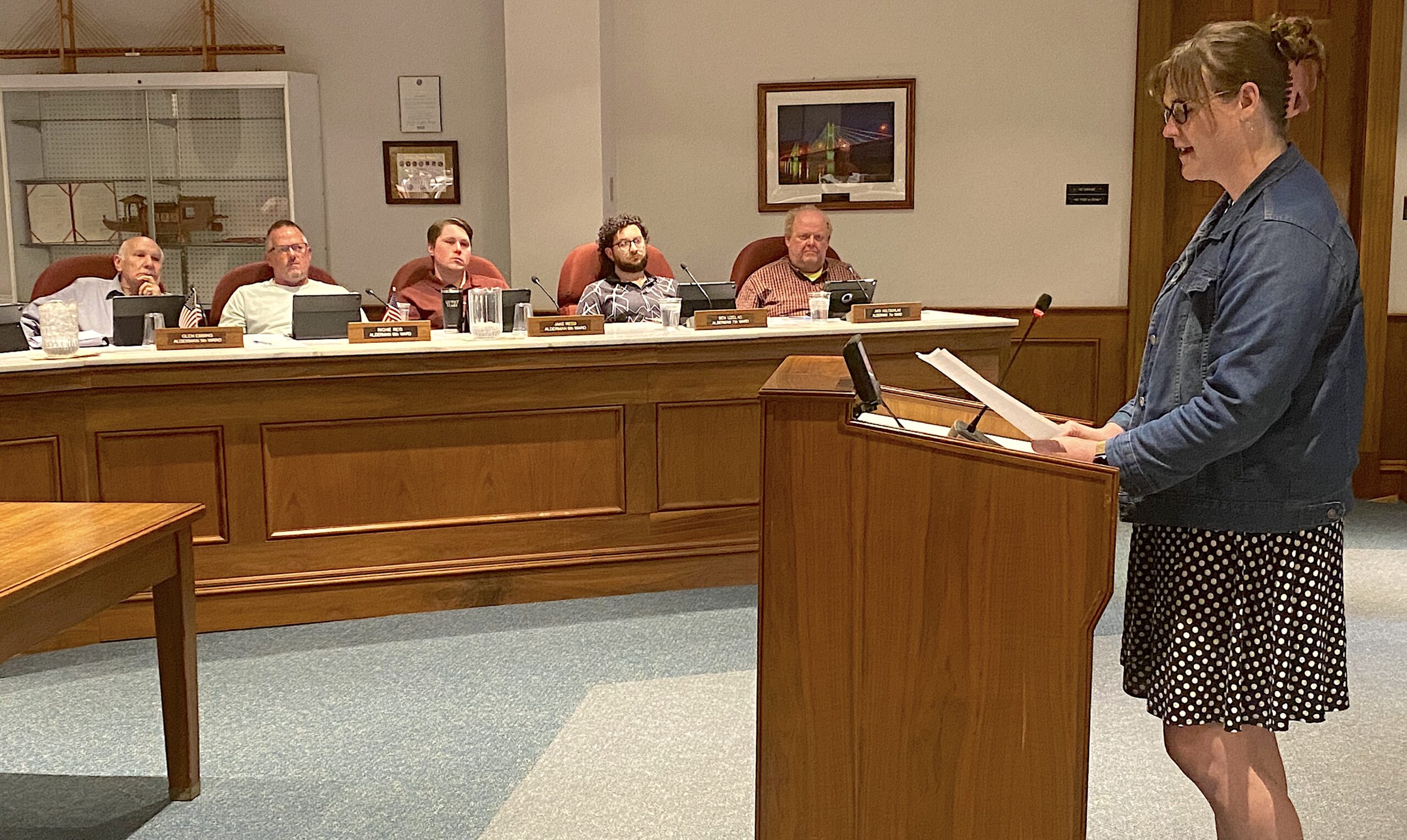Decision on TIF South district tabled for two weeks; Bergman wants to learn voting process for six taxing bodies

QUINCY — A long-awaited vote on an ordinance approving a tax increment financing plan on Quincy’s south side was delayed for two more weeks on Monday night.
The heads of the Great River Economic Development Foundation, Quincy Area Chamber of Commerce and The District made their cases for the city’s third designated TIF zone during last week’s Quincy City Council meeting. TIF districts dedicate a portion of tax revenues generated within the TIF for improvements within those zones. The proposed TIF would be in the German Historic Village area, encompassing 14 square blocks and approximately 125 private parcels around Eighth and State streets.
When it came time for the Quincy City Council to vote on the TIF ordinance, Ben Uzelac (D-7) made a motion to approve the ordinance, and Jack Holtschlag (D-7) seconded the motion. When Mayor Mike Troup asked for discussion among the aldermen, Mike Rein (R-5) spoke first.
“There’s been some recent developments in terms of the Joint Review Board and how it was handled in other taxing districts,” Rein said about the six-person body that voted 5-1 in February in favor of the TIF district. “The degree of confusion is significant, and I think we ought to table it for two weeks.”
Jeff Bergman (R-2) seconded Rein’s motion to table. When Uzelac said, “I’ve already got a motion on the floor,” no other alderman nor the mayor spoke up. Bergman then called for City Planner Chuck Bevelheimer to the podium, and Mike Farha (R-4) said Rein’s motion table took precedence and Uzelac couldn’t talk about his motion.
“The table motion was not seconded,” Troup said.
After Bergman said he seconded Rein’s motion (and several aldermen agreed), Troup said, “I didn’t hear that.”
Uzelac’s motion never was reintroduced. The vote to table the motion was approved 9-4, with Uzelac, Holtschlag, Jake Reed (R-6) and Ken Hultz (R-3) voting no.
Later in the meeting, Bergman asked Bevelheimer to review an email Bergman sent to him Monday morning, asking for the roll call vote on the TIF South district from each of the city’s six taxing bodies (Quincy School Board, Quincy Township, Adams County Board, John Wood Community College, Quincy City Council and Quincy Park District). Each taxing body has one representative on the TIF Joint Review Board.
“The Joint Review Board is, for the statute, the requirement that the city has to seek approval of a TIF district,” Bevelheimer said. “They voted 5-1 to support a recommendation for the TIF district to go forward, and that’s the recommendation that, in essence, staff administration is working off of.
“Prior to that, just like we met with most of you, we went through the TIF redevelopment plan project area with the taxing bodies’ leadership … and asked them if they would like for us to meet with them or meet with their boards in a public session to review that effort. None of the boards asked us to do that. So we felt comfortable that the Joint Review Board represented the taxing bodies in the presentation of the TIF South plan.”
Bergman asked if each taxing body conducted a vote for its support of the new TIF district. (The Quincy Park District was the only taxing body to conduct a public vote, voting 4-3 against it on Jan. 17.) Bevelheimer explained the representatives selected by each taxing district cast their votes, and whether a taxing body decides to publicly vote on the issue beforehand is up to each taxing body.
“I don’t want to interrupt, but (Quincy) Township didn’t send (representative) Lisa Gasko,” Rein said. “We didn’t have a township meeting to discuss it.”
“Well, that’s up to the township. I can’t tell them how they designed that,” Bevelheimer said.
Later Bergman asked, “Did the rest of the governing bodies … did any of the elected officials vote on this? Or was this a decision made by the chairperson or the president of these governing bodies to send any representative to this board to voice their opinion?”
“I don’t have an answer for that,” Bevelheimer said.
“There’s the question,” Bergman said. “There’s a frustration. Therefore, we’re kind of in a gray area right now.”
“There’s not a gray area,” Bevelheimer said. “We followed the statute.”
“What is not gray about the elected officials, who are supposed to be the voice and representing the taxpayers of Adams County, having the information given to them and having the ability to have their voice heard whether or not to give up this excess tax revenue?” Bergman said. “Other than this kind of sounds like a backroom deal to me with a handful of people.”
Troup ended the discussion by saying he would obtain a response from each representative from each of the governing bodies available when the ordinance is discussed at the May 6 meeting.
As aldermen were discussing the tabling of the ordinance, audible groans were heard from a handful in the crowd. Some of them came from Bruce Guthrie, chief executive officer of the Quincy Area Chamber of Commerce, who admitted afterward he was frustrated.
“I thought we were at that position where we could get this thing going and go forward,” he said. “It’s frustrating to think that we’re still questioning things after we’ve been talking about this for months. If we had an issue, I would hope that someone would step forward and talk about this at an earlier time, as opposed to seconds before we’re voting on it.”
After the meeting, Bevelheimer said he will contact the leadership of each taxing body to learn if their board was comfortable with the decision made by their member of the Joint Review Board, as well as how the person to serve on the Joint Review Board was selected.
Asked if he would have liked to have heard Bergman’s questions earlier in the process, Bevelheimer said, “It would have helped … instead of the night of the vote.”
Bergman said after the meeting he didn’t know the Joint Review Board vote was made by a representative, appointed by the chairman or the president of each of the governing bodies, instead of the actual governing bodies themselves.
“The reason we were having questions tonight and wanted a couple of weeks to discuss this was it just seems odd that one person from each of the governing bodies can make the decision of yes or no as opposed to the collective group of elected officials who are supposed to represent the taxpayers and be their voice,” Bergman said.
“They can just go by the yes or no vote from their appointed member of that review board. But just because they have the right to do that, as far as transparency to the taxpayers who are supposed to be represented by each of the elected officials on those boards, that doesn’t mean it’s the right thing to do.”
Several people spoke to the City Council at the beginning of their meeting, offering their support for the TIF South district.
Douglas Peterson, who manages multiple properties near the intersection of Eighth and State, told aldermen of her commitment to Quincy “in a big way.” Peterson took out loans to restore the State Theater and other buildings in disrepair and claimed to have invested more than a half-million dollars in the area since 2021.
“I have taken zero dollars from the city and do not expect any public financing for my private redevelopment project projects,” Peterson said. “My entire life savings, other than my retirement, are invested in this area. I will put my money where my mouth is. I have the receipts to prove it.”
Peterson said areas covered by the TIF district are full of buildings in a state of urban decay with high vacancy and substantial deterioration — while at the same time, some of the buildings can help set Quincy apart as a hub of arts, culture and entertainment.
“Earmarking future gains and property tax revenues for badly needed infrastructure improvement in the area is one straightforward way the city can make a commitment to revitalizing this area of Quincy,” Peterson said. “Dedicating funds for improving the infrastructure in this geographic area is the only way to stem the tide of urban decay and develop this into a shining example of the many gems inside the Gem City.”
Bergman said during the Jan. 22 City Council meeting he would only consider supporting a new TIF District if the city eliminated one of the two existing ones. He said Monday he hopes the two-week tabling of the ordinance allows the taxing bodies to discuss their vote about the TIF district with their voting members.
“There is no requirement on the state or the city to make them do that,” he said. “The whole thing is about transparency to the public. To be honest with you, I think the majority of the council thought all the governing bodies already had the discussion and took a vote amongst themselves, and they were all good with it as a board as a group. But that did not happen, as far as we know.
“It’s got really nothing to do with the TIF district or how we’re going to vote on the TIF district at all, to be honest with you, or the success of it. If it does pass, I hope it has great success. This is just about the process. How did we get from the beginning to here? We just want as much information from all the governing bodies as possible before we vote. That’s all we’re doing.”
Miss Clipping Out Stories to Save for Later?
Click the Purchase Story button below to order a print of this story. We will print it for you on matte photo paper to keep forever.

